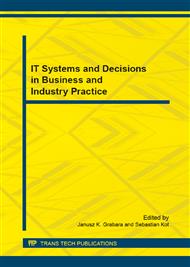[1]
J. Grabara, M. Man, S. Kot, Costs Incurred by Designing and Implementing the Logistical Projects in the Activity of Companies, III Central European Conference on Logistics, Applied Mechanics and Materials. 309 (2013) 221-228.
DOI: 10.4028/www.scientific.net/amm.309.221
Google Scholar
[2]
Pietrzak M., Jałosiński K., Paliszkiewicz J., Brzozowski A. A case study of strategic group map application used as a tool for knowledge management, Journal of Computer Information Systems 55/2 (2015) 68-77.
DOI: 10.1080/08874417.2015.11645758
Google Scholar
[3]
Skowron-Grabowska B. Simulation of supplies and distribution logistics systems, 9th World Multi-Conference on Systemics, Cybernetics and Informatics 3 (2005) 47-50.
Google Scholar
[4]
Wysłocka E., Jelonek D., Nowakowska-Grunt J. Global crisis and casting processes improvement on the example of the polish iron foundry, METAL 2014, 23rd International Conference on Metallurgy and Materials (2014) 1959-(1964).
Google Scholar
[4]
Lech-Mesjasz A., The Use of IT Systems Supporting the Realization of Business Processes in Enterprises and Supply Chains in Poland, Polish Journal of Management Studies 10/2 (2014) 94-103.
Google Scholar
[5]
Ulewicz R., Selejdak J., Borkowski S., Jagusiak-Kocik M. Process management in the cast iron foundry, METAL 2013, 22nd International Conference On Metallurgy And Materials, (2013) 1926-(1931).
Google Scholar
[6]
Konstanciak M. Analysis of technological strategies on the example of the production of the tramway wheels. Archives of Materials Science and Engineering 57/2 (2012), 69-74.
Google Scholar
[7]
Borkowski S., Ulewicz R., Zarządzanie produkcją. Systemy produkcyjne. Wydawnictwo Humanitas, Sosnowiec (2008) 237.
Google Scholar
[8]
Hadaś Ł., Cyplik P., Analiza porównawcza logik przepływu push", "pull", "pull/push, w produkcji – wyniki badań, Logistyka 5 (2007) 43-47.
Google Scholar
[9]
Chakravorty Satya S. An evaluation of DBR control mechanism in a job shop environment, Omega, Volume 29 (2001) 335- 342.
DOI: 10.1016/s0305-0483(01)00028-7
Google Scholar
[10]
Bhardwaj A., Gupta A., Kanda A. Drum-Buffer-Rope: The Technique to Plan and Control the Production Using Theory of Constraints, Word Academy of Science, Engineering and technology, 4 (2010) 89-92.
Google Scholar
[11]
Yang L., Zhang X., Jiang M., An optimal Kanban system in a multi-stage, mixed-model assembly line, J Syst Sci Syst Eng (Mar 2010) 19(1), 36-49.
DOI: 10.1007/s11518-009-5114-1
Google Scholar
[12]
Dallery Y., Liberopoulos G., Extended Kanban control system: combining kanban and base stock, IIE Transactions (2000) 32, 369-386.
DOI: 10.1080/07408170008963914
Google Scholar
[13]
Aghajani M., Keramati A., Javadi B., Determination of number of kanban in a cellular manufacturing system with considering rework process, Int J Adv Manuf Technol (2012) 63, 1177–1189.
DOI: 10.1007/s00170-012-3973-y
Google Scholar
[14]
Kot S., Ślusarczyk B., Aspects of Logistics in Biomass Supply for Energy Production, III Central European Conference on Logistics (2013), 206-212.
DOI: 10.4028/www.scientific.net/amm.309.206
Google Scholar
[15]
Mičieta B., Gregor M., Quirence P., Botka M., Kanban – Ste Na Ťahu, SLCP, Slovenske centrum produkivity, Žilina (2001), 210.
Google Scholar
[16]
Borkowski S., Ulewicz R., Instruments of production processes improvement, PTM, Warszawa (2009), 196.
Google Scholar


